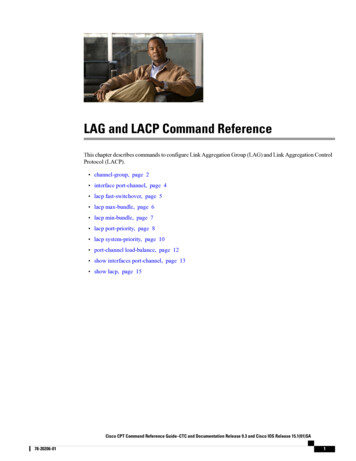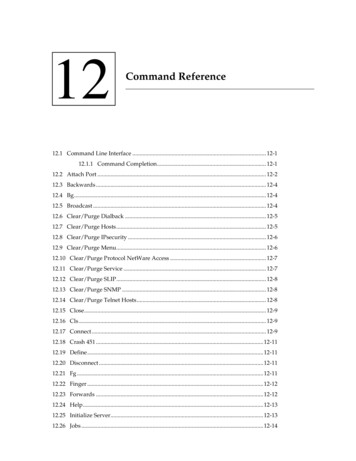
Transcription
LAG and LACP Command ReferenceThis chapter describes commands to configure Link Aggregation Group (LAG) and Link Aggregation ControlProtocol (LACP). channel-group, page 2 interface port-channel, page 4 lacp fast-switchover, page 5 lacp max-bundle, page 6 lacp min-bundle, page 7 lacp port-priority, page 8 lacp system-priority, page 10 port-channel load-balance, page 12 show interfaces port-channel, page 13 show lacp, page 15Cisco CPT Command Reference Guide–CTC and Documentation Release 9.3 and Cisco IOS Release 15.1(01)SA78-20206-011
LAG and LACP Command Referencechannel-groupchannel-groupTo configure the interface in a channel group and set the Link Aggregation Control Protocol (LACP) mode,use the channel-group command in interface configuration mode. To remove the channel-group configurationfrom the interface, use the no form of this command.channel-group channel-group-number mode {active passive}no channel-group channel-group-numberSyntax Descriptionchannel-group-numberInteger that identifies the channel group. The range is from 1 to 128.modeSets the LACP mode.activeEnables LACP unconditionally.passiveEnables LACP only when an LACP device is detected. This is the defaultstate.Command DefaultNo channel groups are assigned.Command ModesInterface configuration (config-if)Command HistoryReleaseModification9.3.0This command was introduced.Usage GuidelinesYou do not have to disable the IP address that is assigned to a physical interface that is part of a channel group,but we highly recommend in doing so. A port-channel must be created before member links are assigned toit.ExamplesThe following example shows how to add the interface TenGigabitEthernet 4/1 to the channel group specifiedby port-channel 1:Router(config)# interface port-channel 1Router(config-if)# exitRouter(config)# interface TenGigabitEthernet 4/1Router(config-if)# channel-group 1Related CommandsCommandDescriptioninterface port-channelCreates a port-channel virtual interface.Cisco CPT Command Reference Guide–CTC and Documentation Release 9.3 and Cisco IOS Release 15.1(01)SA278-20206-01
LAG and LACP Command Referencechannel-groupCommandDescriptionlacp port-prioritySets the LACP priority for a physical interface.lacp system-prioritySets the LACP priority for a system.show interfaces port-channelDisplays traffic that is seen by a specific port channel.Cisco CPT Command Reference Guide–CTC and Documentation Release 9.3 and Cisco IOS Release 15.1(01)SA78-20206-013
LAG and LACP Command Referenceinterface port-channelinterface port-channelTo create a port-channel virtual interface, use the interface port-channel command in global configurationmode.interface port-channel channel-numberSyntax Descriptionchannel-numberChannel number assigned to this port-channel interface.Command DefaultThe port-channel virtual interface is not created.Command ModesGlobal configuration (config)Command HistoryExamplesReleaseModification9.3.0This command was introduced.The following example shows how to create a port-channel interface.Router(config)# interface port-channel 2Related CommandsCommandDescriptionchannel-groupConfigures the interface in a channel group.interface port-channelCreates a port-channel virtual interface.lacp min-bundleDefines the minimum number of active bundledLACP ports allowed in a port channel.lacp max-bundleDefines the maximum number of active bundledLACP ports allowed in a port channel.show interfaces port-channelDisplays traffic that is seen by a specific port channel.Cisco CPT Command Reference Guide–CTC and Documentation Release 9.3 and Cisco IOS Release 15.1(01)SA478-20206-01
LAG and LACP Command Referencelacp fast-switchoverlacp fast-switchoverTo enable LACP 1:1 link redundancy, use the lacp fast-switchover command in interface configuration mode.To disable LACP 1:1 link redundancy, use the no form of this command.lacp fast-switchoverno lacp fast-switchoverSyntax DescriptionThis command has no arguments or keywords.Command DefaultLACP 1:1 link redundancy is disabled by default.Command ModesInterface configuration (config-if)Command HistoryUsage GuidelinesReleaseModification9.3.0This command was introduced.Before entering the lacp fast-switchover command, ensure the following: The port channel protocol type is LACP. The lacp max-bundle command has been entered on the port channel. The lacp fast-switchovercommand does not affect the lacp max-bundle command.When you enable LACP 1:1 link redundancy, based on the system priority and port priority, the port with thehigher system priority chooses the link as the active link and the other link as the standby link. When theactive link fails, the standby link is selected as the new active link without taking down the port channel.When the original active link recovers, it reverts to its active link status. During this switch over, the portchannel is also up.ExamplesThe following example shows how to enable LACP 1:1 link redundancy:Router(config-if)# lacp fast-switchoverRelated CommandsCommandDescriptionlacp max-bundleDefines the maximum number of active bundledLACP ports allowed in a port channel.Cisco CPT Command Reference Guide–CTC and Documentation Release 9.3 and Cisco IOS Release 15.1(01)SA78-20206-015
LAG and LACP Command Referencelacp max-bundlelacp max-bundleTo define the maximum number of active bundled LACP ports allowed in a port channel, use the lacpmax-bundle command in interface configuration mode. To return to the default settings, use the no form ofthis command.lacp max-bundle max-bundle-numberno lacp max-bundleSyntax Descriptionmax-bundle-numberMaximum threshold of active member links allowed in the LACP bundle. Therange from is 1 to 8. The maximum threshold value must be greater than or equalto the minimum threshold value.Command DefaultA maximum number of active bundled LACP ports is not configured.Command ModesInterface configuration (config-if)Command HistoryReleaseModification9.3.0This command was introduced.Usage GuidelinesThe value specified in the max-bundle-number argument determines the number of active links that are bundledin the port channel. The remaining links are in hot-standby mode.ExamplesThe following example shows how to set three ports to bundle in port channel 2:Router(config)# interface port-channel 2Router(config-if)# lacp max-bundle 3Related CommandsCommandDescriptioninterface port-channelCreates a port-channel virtual interface.lacp fast-switchoverEnables LACP 1:1 link redundancy.lacp port-prioritySets the LACP priority for a physical interface.show interfaces port-channelDisplays traffic that is seen by a specific port channel.Cisco CPT Command Reference Guide–CTC and Documentation Release 9.3 and Cisco IOS Release 15.1(01)SA678-20206-01
LAG and LACP Command Referencelacp min-bundlelacp min-bundleTo define the minimum number of active bundled LACP ports allowed in a port channel, use the lacpmin-bundle command in interface configuration mode. To return to the default settings, use the no form ofthis command.lacp min-bundle min-bundle-numberno lacp min-bundleSyntax Descriptionmin-bundle-numberMinimum threshold of active member links allowed in the LACP bundle.The range is from 1 to 8. The default is 1.Command DefaultA minimum number of active bundled LACP ports is not configured.Command ModesInterface configuration (config-if)Command HistoryReleaseModification9.3.0This command was introduced.Usage GuidelinesUse this command to configure the minimum number of active links allowed in an LACP bundle. When thenumber of active links falls below this minimum threshold, the port channel shuts down.ExamplesThe following example shows how to set the minimum number of active links to five ports:Router(config)# interface port-channel 2Router(config-if)# lacp min-bundle 5Related CommandsCommandDescriptioninterface port-channelCreates a port-channel virtual interface.show interfaces port-channelDisplays traffic that is seen by a specific port channel.Cisco CPT Command Reference Guide–CTC and Documentation Release 9.3 and Cisco IOS Release 15.1(01)SA78-20206-017
LAG and LACP Command Referencelacp port-prioritylacp port-priorityTo set the LACP priority for a physical interface, use the lacp port-priority command in interface configurationmode. To return to the default setting, use the no form of this command.lacp port-priority priorityno lacp port-prioritySyntax DescriptionpriorityInteger that indicates the priority for the physical interface. The range is from 0 to65535. The default is 32768.Command DefaultThe default port priority is set to 32768.Command ModesInterface configuration (config-if)Command HistoryUsage GuidelinesNoteReleaseModification9.3.0This command was introduced.You may assign a port priority to each port on a device running LACP. You can specify the port priority byusing the lacp port-priority command or use the default port priority (32768). The port priority is used todecide which ports should be put in standby mode when a hardware limitation or the lacp max-bundlecommand configuration prevents all compatible ports from aggregating. Priority is supported only on portchannels with LACP-enabled physical interfaces.A high priority number means a low priority.To verify the configured port priority, use the show lacp internal command.ExamplesThe following example shows how to set a port priority of 23700 for an interface:Router(config-if)# lacp port-priority 23700Related CommandsCommandDescriptionchannel-groupCreates a channel group.Cisco CPT Command Reference Guide–CTC and Documentation Release 9.3 and Cisco IOS Release 15.1(01)SA878-20206-01
LAG and LACP Command Referencelacp port-priorityCommandDescriptionlacp max-bundleDefines the maximum number of active bundledLACP ports allowed in a port channel.lacp system-prioritySets the LACP system priority.show lacpDisplays information about LACP activity on thedevice.Cisco CPT Command Reference Guide–CTC and Documentation Release 9.3 and Cisco IOS Release 15.1(01)SA78-20206-019
LAG and LACP Command Referencelacp system-prioritylacp system-priorityTo set the LACP priority for a system, use the lacp system-priority command in global configuration mode.To return to the default setting, use the no form of this command.lacp system-priority priorityno lacp system-prioritySyntax DescriptionpriorityInteger that indicates the LACP priority for the system. The range is from 0 to65535. The default is 32768.Command DefaultThe default system priority is set to 32768.Command ModesGlobal configuration (config)Command HistoryUsage GuidelinesNoteReleaseModification9.3.0This command was introduced.You can assign a system priority to each device running LACP. You can specify the system priority by usingthe lacp system-priority command or use the default system priority (32768). The system priority is usedwith the MAC address of the device to form the system ID and is used during negotiation with the othersystems. The system priority is supported only on port channels with LACP-enabled physical interfaces.A high priority number means a low priority.To verify the configured system priority, issue the show lacp command.ExamplesThe following example shows how to set a system priority of 25500 for a device:Router(config)# lacp system-priority 25500Related CommandsCommandDescriptionchannel-groupCreates a channel group.lacp port-prioritySets the priority of a port.Cisco CPT Command Reference Guide–CTC and Documentation Release 9.3 and Cisco IOS Release 15.1(01)SA1078-20206-01
LAG and LACP Command Referencelacp system-priorityCommandDescriptionshow lacpDisplays information about LACP activity on thedevice.Cisco CPT Command Reference Guide–CTC and Documentation Release 9.3 and Cisco IOS Release 15.1(01)SA78-20206-0111
LAG and LACP Command Referenceport-channel load-balanceport-channel load-balanceTo configure a member link for load balancing, use the port-channel load-balance command in interfaceconfiguration mode. To disable load balancing, use the no form of this command.port-channel load-balance {link link-id}Syntax Descriptionlink link-idInteger that identifies the member link for load balancing. The range is from1 to 8.Command DefaultThe member link is not configured for load balancing.Command ModesInterface configuration (config-if)Command HistoryReleaseModification9.3.0This command was introduced.Usage GuidelinesThe Cisco CPT supports manual load balancing and platform default load balancing. It does not supportweighted load balancing in this release. When manual load balancing is not configured and applied to theservice instance, the default platform load balancing mechanism is used.ExamplesThe following example shows how to configure manual load balancing:Router(config)# interface port-channel 1Router(config-if)# port-channel load-balance link 1Cisco CPT Command Reference Guide–CTC and Documentation Release 9.3 and Cisco IOS Release 15.1(01)SA1278-20206-01
LAG and LACP Command Referenceshow interfaces port-channelshow interfaces port-channelTo display the traffic on specific port channel, use the show interfaces port-channel command in privilegedEXEC mode.show interfaces port-channel channel-numberSyntax DescriptionCommand ModesCommand HistoryExampleschannel-number(Optional) Port channel number. The range is 1 to 128.Privileged EXEC (#)ReleaseModification9.3.0This command was introduced.The following is a sample output of the show interfaces port-channel command that shows how to view theinformation for a port channel interface.Router# show interfaces port-channel 20Port-channel20 is up, line protocol is upHardware is GEChannel, address is 0002.0415.0002 (bia 0000.0000.0000)MTU 9600 bytes, BW 10000000 Kbit/sec, DLY 10 usec,reliability 255/255, txload 1/255, rxload 1/255Encapsulation ARPA, loopback not setKeepalive set (10 sec)ARP type: ARPA, ARP Timeout 04:00:00No. of active members in this channel: 1Member 0 : TenGigabitEthernet4/2 , Full-duplex, 10000Mb/sNo. of passive members in this channel: 0Last input never, output never, output hang neverLast clearing of "show interface" counters neverInput queue: 0/75/0/0 (size/max/drops/flushes); Total output drops: 0Queueing strategy: fifoOutput queue: 0/40 (size/max)5 minute input rate 0 bits/sec, 0 packets/sec5 minute output rate 0 bits/sec, 0 packets/sec37 packets input, 7820 bytes, 0 no bufferReceived 0 broadcasts (0 IP multicasts)0 runts, 0 giants, 0 throttles0 input errors, 0 CRC, 0 frame, 0 overrun, 0 ignored0 watchdog, 0 multicast, 0 pause input39 packets output, 8088 bytes, 0 underruns0 output errors, 0 collisions, 0 interface resets0 unknown protocol drops0 babbles, 0 late collision, 0 deferredCisco CPT Command Reference Guide–CTC and Documentation Release 9.3 and Cisco IOS Release 15.1(01)SA78-20206-0113
LAG and LACP Command Referenceshow interfaces port-channel0 lost carrier, 0 no carrier, 0 pause output0 output buffer failures, 0 output buffers swapped outRelated CommandsCommandDescriptionchannel-groupConfigures the interface in a channel group and setsthe LACP mode.interface port-channelCreates a port-channel virtual interface.lacp max-bundleDefines the maximum number of active bundledLACP ports allowed in a port channel.lacp min-bundleDefines the minimum number of active bundledLACP ports allowed in a port channel.Cisco CPT Command Reference Guide–CTC and Documentation Release 9.3 and Cisco IOS Release 15.1(01)SA1478-20206-01
LAG and LACP Command Referenceshow lacpshow lacpTo display LACP information, use the show lacp command in privileged EXEC mode.show lacp {channel-group-number counters internal [detail] neighbor [detail] sys-id}Syntax DescriptionCommand ModesCommand Historychannel-group-numberNumber of the channel group. The range is from 1 to 128.countersDisplays information about the LACP traffic statistics.internalDisplays LACP internal information.detail(Optional) Displays detailed internal information.neighborDisplays information about the LACP neighbor.sys-idDisplays the LACP system identification. It is a combination of the portpriority and the MAC address of the device.Privileged EXEC (#)ReleaseModification9.3.0This command was introduced.Usage GuidelinesUse the show lacp command to troubleshoot problems related to LACP in a network. If you do not specifya value for the argument channel-group-number, all the channel groups are displayed.ExamplesThe following are sample outputs of the show lacp command that shows how to view the LACP activity inthe network.Router# show lacp internalFlags:S - Device is requesting Slow LACPDUsF - Device is requesting Fast LACPDUsA - Device is in Active modeP - Device is in Passive modeChannel group 20PortTe4/2Flags StateSAbndlLACP 42PortState0x3DRouter# show lacp 20 countersCisco CPT Command Reference Guide–CTC and Documentation Release 9.3 and Cisco IOS Release 15.1(01)SA78-20206-0115
LAG and LACP Command Referenceshow lacpPortLACPDUsSentRecvMarkerSentRecvMarker ResponseSentRecvLACPDUsPkts ---------------------Channel group 20Te4/2211800000Router# show lacp 20 internalFlags:S - Device is requesting Slow LACPDUsF - Device is requesting Fast LACPDUsA - Device is in Active modeP - Device is in Passive modeChannel group 20PortTe4/2Flags StateSAbndlLACP 42PortState0x3DRouter# show lacp 20 countersLACPDUsMarkerMarker ResponseLACPDUsPortSentRecvSentRecvSentRecvPkts -------------------------------Channel group: 20Te4/2263100000Router# show lacp sys-id32768,0005.9b2e.18e0Related CommandsCommandDescriptionlacp port-prioritySets the priority for the physical interfaces.lacp system-prioritySets the priority of the system.Cisco CPT Command Reference Guide–CTC and Documentation Release 9.3 and Cisco IOS Release 15.1(01)SA1678-20206-01
Router(config)#interfaceport-channel1 Router(config-if)#exit Router(config)#interfaceTenGigabitEthernet4/1 Router(config-if)#channel-group1 Related Commands Command Description interfaceport-channel Createsaport-channelvirtualinterface. Cisco CPT Command Reference Guide-CTC and Documentation Release 9.3 and Cisco IOS Release 15.1(01)SA 2 78 .










